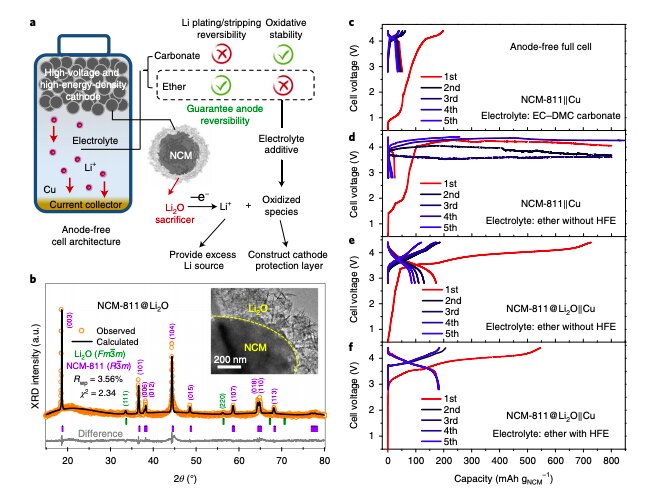
A high-energy density and long-life initial-anode-free lithium battery

Lithium-metal batteries (LMBs), an emerging type of rechargeable lithium-based batteries made of solid-state metal instead of lithium-ions, are among the most promising high-energy-density rechargeable battery technologies. Although they have some advantageous characteristics, these batteries have several limitations, including a poor energy density and safety-related issues.
In recent years, researchers have tried to overcome these limitations by introducing an alternative, anode-free lithium battery cell design. This anode-free design could help to increase the energy density and safety of lithium-metal batteries.
Researchers at the National Institute of Advanced Industrial Science and Technology recently carried out a study aimed at increasing the energy density of anode-free lithium batteries. Their paper, published in Nature Energy, introduces a new high-energy-density and long-life anode-free lithium battery based on the use of a Li2O sacrificial agent.
Anode-free full-cell battery architectures are typically based on a fully lithiated cathode with a bare anode copper current collector. Remarkably, both the gravimetric and volumetric energy densities of anode-free lithium batteries can be extended to their maximum limit. Anode-free cell architectures have several other advantages over more conventional LMB designs, including a lower cost, greater safety and simpler cell assembly procedures.
To unlock the full potential of anode-free LMBs, researchers should first figure out how to achieve the reversibility/stability of Li-metal plating. While many have tried to solve this problem by engineering and selecting more favorable electrolytes, most of these efforts have so far been unsuccessful.
Others have also explored the potential of using salts or additives that could improve the Li-metal plating/stripping reversibility. After reviewing these previous attempts, the researchers at the National Institute of Advanced Industrial Science and Technology proposed the use of Li2O as a sacrificial agent, which is pre-loaded onto a LiNi0.8Co0.1Mn0.1O2 surface.
“It is challenging to realize high Li reversibility, especially considering the limited Li reservoir (typically zero lithium excess) in the cell configuration,” the researchers wrote in their paper. “In this study we have introduced Li2O as a preloaded sacrificial agent on a LiNi0.8Co0.1Mn0.1O2 cathode, providing an additional Li source to offset the irreversible loss of Li during long-term cycling in an initial-anode-free cell.”
In addition to employing Li2O as a sacrificial agent, the researchers proposed the use of a fluoropropyl ether additive to neutralize nucleophilic O2-, which is released during the oxidation of Li2O, and prevent the additional evolution of gaseous O2 resulting from the fabrication of a LiF-based electrolyte coated on the surface of the battery’s cathode.
“We show that O2– species, released through Li2O oxidation, are synergistically neutralized by a fluorinated ether additive,” the researchers explained in their paper. “This leads to the construction of a LiF-based layer at the cathode/electrolyte interface, which passivates the cathode surface and restrains the detrimental oxidative decomposition of ether solvents.”
Based on the design they devised, Yu Qiao and the rest of the team at the National Institute of Advanced Industrial Science and Technology were able to realize a long-life 2.46 Ah initial-anode-free pouch cell. This cell exhibited a gravimetric energy density of 320 Wh kg-1, maintaining an 80% capacity after 300 operation cycles.
In the future, the anode-free lithium battery introduced by this research group could help to overcome some of the commonly reported limitations of LMBs. In addition, its design could inspire the creation of safer lithium-based rechargeable batteries with higher energy densities and longer lifetimes.
A high-energy-density and long-life initial-anode-free lithium battery enabled by a Li2O sacrificial agent. Nature Energy(2021). DOI: 10.1038/s41560-021-00839-0.
© 2021 Science X Network
Citation:
A high-energy density and long-life initial-anode-free lithium battery (2021, July 8)
retrieved 8 July 2021
from https://techxplore.com/news/2021-07-high-energy-density-long-life-initial-anode-free-lithium.html
This document is subject to copyright. Apart from any fair dealing for the purpose of private study or research, no
part may be reproduced without the written permission. The content is provided for information purposes only.
Stay connected with us on social media platform for instant update click here to join our Twitter, & Facebook
We are now on Telegram. Click here to join our channel (@TechiUpdate) and stay updated with the latest Technology headlines.
For all the latest Technology News Click Here
For the latest news and updates, follow us on Google News.

